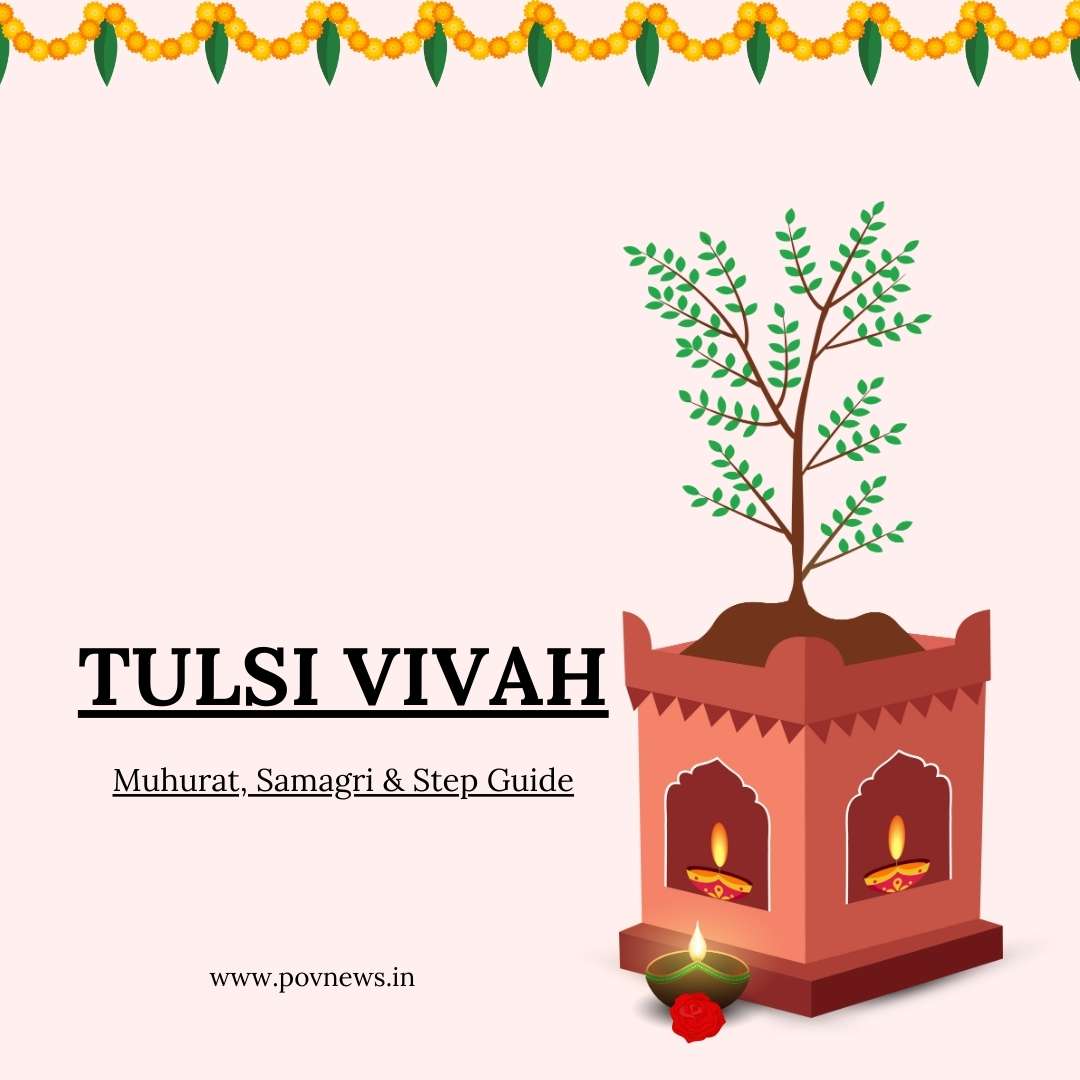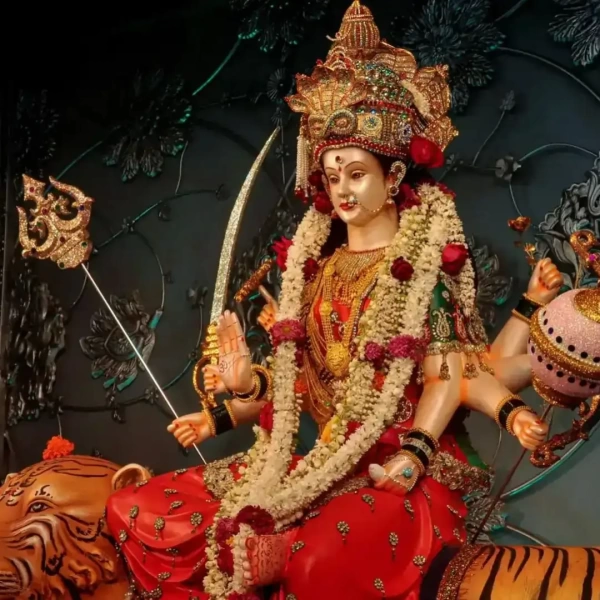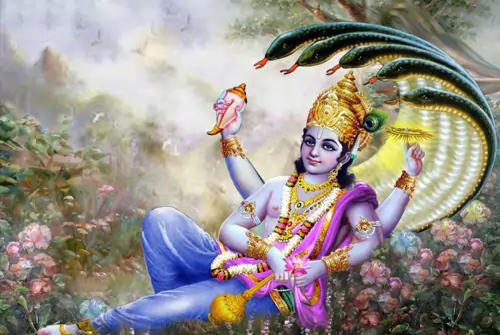Tulsi Vivah 2025, an auspicious Hindu wedding of the sacred Tulsi plant (holy basil) and Lord Vishnu in his Shaligram form, will be celebrated on Sunday, November 2, 2025 (Kartik Shukla Dwadashi). This festival marks the beginning of the Hindu wedding season and is deeply revered for its spiritual, mythological, and cultural significance. Below is a comprehensive blog framework for “Tulsi Vivah 2025: Date, Puja Vidhi & Marriage Significance,” suitable for a 5000-word article, centered around the keyword Tulsi Vivah 2025.
Also read- Festival in October 2025: Complete List of Hindu Festivals
Introduction
Tulsi Vivah is one of the most beloved and spiritually significant rituals in Hindu tradition, symbolizing the union of the sacred plant Tulsi and Lord Vishnu (often in Shaligram or Krishna avatar). This divine marriage not only marks the onset of the human wedding season in India but is also considered a celebration of the victory of purity, devotion, and the Divine Feminine. It is performed with deep devotion, elaborate preparation, and timeless joy by families, temples, and communities across India.
Tulsi Vivah 2025: Date, Tithi & Muhurat
Date: Sunday, November 2, 2025 (Kartik Shukla Dwadashi)
- Dwadashi Tithi Begins: 2 November, 7:31 AM IST
- Dwadashi Tithi Ends: 3 November, 5:07 AM IST
Best Muhurat for Vivah:
- Morning: 9:00 AM to 11:30 AM IST
- Evening: 5:00 PM to 7:30 PM IST
(Check local panchang for regional timings and adjustment).
Mythological Story of Tulsi Vivah
At the heart of Tulsi Vivah lies the poignant legend of Brinda (Vrinda), the devoted wife of the demon king Jalandhar. Brinda’s unwavering chastity protected her husband from defeat. To end Jalandhar’s tyranny, Lord Vishnu tricked Brinda, making Jalandhar vulnerable and leading to his death. Betrayed, Brinda cursed Lord Vishnu to become stone (Shaligram). In compassion, Vishnu transformed Brinda into the sacred Tulsi plant and vowed to marry her every year in the month of Kartik.
This promise is fulfilled in the ceremonial wedding of Tulsi and Shaligram, symbolizing forgiveness, renewal, and the eternal union of humanity with divinity.
Puja Vidhi: Step-by-Step Ceremony
1. Preparations
- Clean the Home & Courtyard: The area where the puja is performed, traditionally near a Tulsi plant in the courtyard, must be cleaned and decorated with rangoli, flowers, and lamps.
- Mandap Setup: A wedding mandap or altar is created using sugarcane stalks, colorful cloth, mango leaves, and garlands.
- Tulsi Plant Dressing: The Tulsi plant is adorned as a bride—with a saree, jewels, bindi, bangles, and jewelry. Shaligram or Krishna idol is decorated as the groom.
2. Puja Thali Arrangement
- Sandalwood paste, turmeric, kumkum, rice, red thread (mauli)
- Fruits, coconut, sweets (especially laddoo), betel leaves
- New cloth or saree for the bride Tulsi
- Lamp (diya) filled with ghee
3. Marriage Rituals
- Sankalp (Prayer of Intent): Family members declare their resolve to perform Tulsi Vivah with devotion.
- Invocation: Begin with prayers to Lord Ganesha, seeking removal of obstacles.
- Worship of Tulsi & Shaligram: Apply sandalwood paste and kumkum to the Tulsi plant and Shaligram.
- Kanyadaan (Giving Away the Bride): Devotees symbolically give away the Tulsi plant as their daughter, pour water, and chant mantras
- Seven Circumambulations (Saat Phere): Devotees circumambulate Tulsi and Shaligram seven times, symbolizing the seven vows of marriage.
- Var Mala (Garland Exchange): Garland the Tulsi plant and place the other on Shaligram.
- Prasad Distribution: Offer coconut, fruits, sweets, and finally distribute as prasad to participants.
- Aarti & Bhajan: Conclude with aarti and devotional songs celebrating Tulsi and Vishnu.
Spiritual & Cultural Significance
- Spiritual Merit: Tulsi Vivah is considered equivalent to performing kanyadaan, one of the highest charitable acts in Hinduism. Devotees believe it brings peace, prosperity, happiness, and the blessings of married life and ideal children.
- Marriage Season Begins: Tulsi Vivah marks the end of the four-month “Chaturmas” period, when auspicious events are avoided. After Tulsi Vivah, weddings, grihapravesh (housewarmings), and naming ceremonies resume across Hindu society.
- Union of Bhakti and Purusha: Tulsi Devi is an incarnation of Lakshmi (Purity, Devotion), and Shaligram is a symbol of Vishnu (Eternal Masculine). Their marriage signifies harmony, balance, and the confluence of divine energies.
Tulsi – The Sacred Plant: Symbol and Benefits
Tulsi (Ocimum sanctum) stands as one of the most revered plants in India:
- Purifies environment, air, and mind
- Central to daily worship and every major puja
- Symbolizes faith, protection, and divine grace
- Associated with medicinal properties—immunity, health, and detoxification.
Regional Variations & Social Customs
- North India: Elaborate pujas, singing folk songs, and serving sweets like laddoos and matar ke kachoris.
- West Bengal & Odisha: Traditional bhog includes khichdi, malpua, and seasonal fruits.
- Maharashtra: Women offer jaggery sweets and turmeric-based dishes, emphasizing the auspiciousness of turmeric.
- South India: Alongside Tulsi Vivah, rituals celebrate Krishna’s childhood with devotional music and prasadam distribution.
Tulsi Vivah at Home and in Temples
Temples conduct grand celebrations with beautifully decorated mandaps, processions, and community feasts. In homes, family and neighbors gather for the understated, heartfelt ceremony. The ritual nurtures togetherness and extends blessings to all participants.
Here is additional rich content for your 5000-word blog on Tulsi Vivah 2025, covering modern innovations, eco-friendly trends, astrology, social importance, and detailed ritual expansions:
Tulsi Vivah 2025 Modern Celebrations and Innovations
Contemporary Adaptations
Tulsi Vivah 2025 reflects a beautiful blend of ancient tradition and modern lifestyle. Urban households and temples adapt the ritual to suit space constraints and busy schedules, sometimes conducting the wedding ceremony with potted Tulsi plants on balconies or tabletops decorated with LED lights and artificial flowers.
Virtual participation has gained popularity, where families livestream the ceremony for relatives unable to attend physically. Social media platforms see an outpouring of photos, videos, and live bhajans that make this auspicious day accessible to the Indian diaspora worldwide.
Eco-Conscious Celebrations
The rise of environmental awareness encourages devotees to use biodegradable materials—natural dyes for rangoli, organic flowers, and earthen lamps—to honor Tulsi without harming nature. Many communities organize Tulsi plantation drives alongside the wedding to promote ecological balance, symbolically linking reverence for the plant with environmental action.
Astrological Significance of Tulsi Vivah 2025
The planetary alignment in 2025 brings extra auspiciousness to Tulsi Vivah. Jupiter’s transit in Aquarius and its positive aspect with Venus enhance harmony, prosperity, and spiritual growth during the festivities.
Expanded Puja Vidhi Details
Dress and Decoration
Brides often wear traditional red or orange sarees.Devotees adorn the Tulsi plant by wrapping it in colorful cloth, decorating it with jewelry, and painting a bindi on the stem or leaves. They dress the groom idol (Shaligram) in a dhoti and shawl, and decorate it with flowers, placing it reverently next to the Tulsi.
Mantras and Vedic Chants
Chanting remains central—recitation of the “Tulsi Vivah Mantra,” “Om Namo Bhagavate Vasudevaya,” and various lakshmi-vishnu stotras invoke divine blessings. Priests often sing “Mangalashtaka,” a series of auspicious verses regarded as essential for the sanctity of the marriage ritual.
Symbolic Rituals
- Kanyadaan: Offering Tulsi as the bride echoes the sacred act of giving away a daughter in marriage, symbolizing purity and virtue.
- Saat Phere: The circumbulation ritual seals the sacred union and commitment between Tulsi and Vishnu.
- Exchange of Garland and Sindoor: Demonstrates mutual acceptance and eternal bonding.
- Offering Panchamrit and Prasad: Nourishes and blesses all participants, symbolizing prosperity and gratitude.
Spiritual and Social Dimensions
Tulsi Vivah transcends ceremonial importance—it nurtures community bonds, sustains cultural heritage, and encourages spiritual contemplation. Women traditionally observe fasts or vrat, praying for marital bliss, fertility, and family harmony. The festival also symbolizes renewal, marking auspicious beginnings, with many couples choosing this day for weddings or engagements.
In recent times, social groups and temple organizations utilize Tulsi Vivah to promote women’s empowerment, environmental consciousness, and cultural education, hosting workshops and charity events to extend the ritual’s impact.
Regional Customs & Culinary Traditions
- North India: Elaborate pujas, singing folk songs, and serving sweets like laddoos and matar ke kachoris.
- West Bengal & Odisha: Traditional bhog includes khichdi, malpua, and seasonal fruits.
- Maharashtra: Women offer jaggery sweets and turmeric-based dishes, emphasizing the auspiciousness of turmeric.
- South India: Alongside Tulsi Vivah, rituals celebrate Krishna’s childhood with devotional music and prasadam distribution.
Tips for Hosting a Blessed Tulsi Vivah in 2025
- Select a fresh, healthy Tulsi plant preferably grown at home or a nearby temple.
- Prepare all puja materials cleanly, using organic and natural products.
- Invite family members and community to share in prayers and festivities to enhance collective positivity.
- Incorporate traditional music and devotional singing to deepen spiritual connection.
- Distribute prasad generously as a symbol of shared blessings and goodwill.
Sustainability and Contemporary Trends
- Virtual celebrations, especially among the diaspora, connect families by streaming their Tulsi Vivah rituals online.
- Cultural organizations conduct Tulsi Vivah with social messaging about women’s empowerment and environmental protection.
FAQs & Practical Guidance
| Question | Answer |
|---|---|
| When is Tulsi Vivah 2025? | Sunday, November 2, 2025 (Kartik Shukla Dwadashi). |
| Muhurat for Tulsi Vivah | Morning: 9:00–11:30 AM IST. Evening: 5:00–7:30 PM IST (consult local panchang for adjustments). |
| What is Tulsi Vivah? | The ceremonial wedding of Tulsi plant and Lord Vishnu/Shaligram, representing divinity and devotion. |
| Why do Hindus perform Tulsi Vivah? | To gain spiritual merit, open auspicious occasions, and honor the sacred bond of purity and masculinity. |
| Can Tulsi Vivah be performed at home? | Yes, and it is commonly done by families with Tulsi plants in their courtyards or balconies, following the simple puja vidhi listed above. |
| Is there a story behind Tulsi Vivah? | Yes, it is rooted in the tale of Brinda and Jalandhar, culminating in Tulsi and Vishnu’s divine union as Shaligram. |
Conclusion
Tulsi Vivah 2025 is a festival that bridges the spiritual, the ecological, and the communal—the sacred marriage of Tulsi and Lord Vishnu serves as a metaphor for devotion, protection, harmony, and renewal. By participating with faith and sincerity, devotees bless their families, seek marital harmony, and usher in a season of joy and auspiciousness. Whether observed in a grand temple ceremony or a humble household setting, Tulsi Vivah resonates as an eternal celebration of the union between humanity and the divine.
Also read – Bhai Dooj 2025: Date, Tilak Vidhi & Story



1 Comment